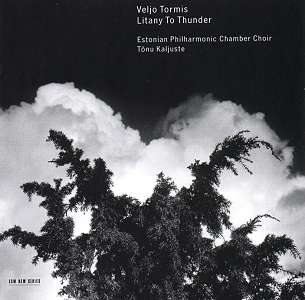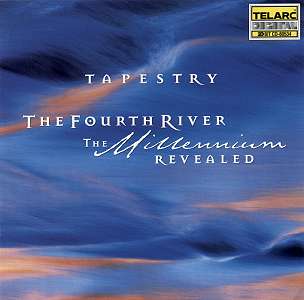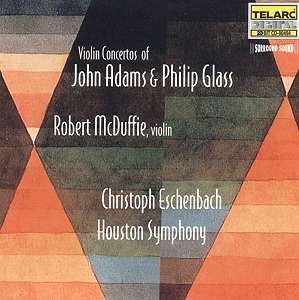Music Reviews
Classical Music - Part 8 - February, 2000
Jason Serinus
Ratings: 
Extraordinary 
Good 
Acceptable 
Mediocre 
Poor

"Litany to Thunder"
Veljo Tormis, Estonian Philharmonic Chamber Choir, Tonu Kaljuste
ECM New Series 1687; 465 223-2
Performance: 
Audio: 
�I do not use folk song. It is folk song that uses me. To me, folk music is not a means of self-expression; on the contrary, I feel the need to express the essence of folk music, its spirit, meaning and form.�
The songs of Estonian composer Veljo Tormis (b. 1930) speak of an ancient past and rugged life in which spirituality is integral to daily existence. A relief from the mindless repetition which one too often encounters passing itself for music, the runo-songs (repetitive short recitatives, performed as a call and response) that frame this album�s eight selections �link modern Estonians to the ancient pre-Christian shamanistic culture practiced by the Baltic Finnic peoples around the Gulf of Finland.�
Whether or not one might legitimately consider some of this music as Estonia�s timeless answer to hip-hop, I found it jaw-dropping and consistently hypnotic. Within seconds, I was hooked. Whether hearing the angelic, almost na�ve voices of young sopranos, rumbling chants and shouts of deep-voiced men, and/or soul-shaking drumbeats, I was immediately drawn in.
Tormis captures the essence of shamanic practice -- raw, visceral, magical and animal-like -- and remains consistently in touch with both the forces of nature and the passions of the human heart. His ability to take genuine folk melodies and surround them with frequently spare, but harmonically sophisticated accompaniments, elevates them to another dimension. It is interesting to compare his mastery in this regard with that of contemporary English composer Benjamin Britten. But the melodies here, whether traditional or composed by Tormis, speak directly of elemental forces that much of English folk music addresses in far more polite terms.
The Estonian singers are fully up to the task at hand. Their voices seem to usher forth naturally from the deepest places within. Everything about this CD, in fact, speaks of conviction and perfection.
The Estonian Philharmonic Chamber Choir and the Tallinn Chamber Orchestra, both of which feature on many superb ECM recordings, are about to embark on a North American tour. They begin in Toronto on February 4, 2000, perform in New York, Lafayette College, Kansas City, Manhattan KS, Ann Arbor, Chicago, Decatur, Houston, and San Francisco, and end in Vancouver on February 20, 2000. If you can find the means to attend, by all means do.
- Jason Serinus -

"The Fourth River: The Millennium Revealed"
Tapestry
Telarc; CD-80534
Performance: 
Audio: 
In their fourth CD for Telarc, the Tapestry women�s vocal trio creates a musical portrait of sacred thought associated with the millennium. Drawing upon such ancient sources as Hebrew prayers from the Old Testament, the Notre Dame Repertory, the Christian mystic Hildegard von Bingen, a sixth century Greek text, the inspiration of 13th century Sufi mystic Jalaluddin Rumi, Tapestry sings both medieval and modern vocal compositions with a soulful reverence that does full justice to the subject matter.
Perhaps you will relate to the ultimate focus of Tapestry�s collection: �the light of hope and love for [humankind] that are the counterpart of [our darkest and most apocalyptic] fears.� As I have listened to this group�s journey, beginning with contemporary composer Patricia Van Ness� song dedicated to the angel Michael (who plays a part in Hebrew, Christian, and Islamic religions), and ending with contemporary composer Gabriel Jackson�s beautiful, destructively apocalyptic and yet spiritually affirming At the Last Day, I have been struck mostly by the beauty and harmony that we as humans can create when voice, heart, and mind unite. As Richard Landes, Director of the Center for Millennial Studies (http://www.mille.org) says in his introduction to the recording, millennialism is the belief that �at some point in the future this world will be radically transformed into a place of peace, fellowship, and abundance . . . .�
Abundance is the key to this unique collection. Mezzo Laurie Monahan, soprano Cristi Catt and alto Daniela Tosic of Tapestry, here sometimes abetted by soprano Lynn Torgove and percussionist Takaaki Masuko, have a very different sound than the superb women�s vocal quartet, Anonymous 4. While their sound is less liquid and homogenized than the more famous quartets, Tapestry�s vibratoless, sometimes dry voices have much impact, especially when Catt�s high soprano, sounding something like a boy soprano�s sans naivete, reaches into what seems like the beyond. Even when texts are ascetic, the presentation is rich in spirit.
A definite change of pace. Telarc�s 20 to 16-bit sound has much presence and depth, as well as brightness. Rarely will you encounter such a visionary collection.
- Jason Serinus -

"Violin Concertos of John Adams and Philip Glass"
Robert McDuffie, Violin, Christoph Eschenbach, Houston Symphony Orchestra
Telarc; CD-80494
Performance: 
Audio: 
This important recording, now available through the BMG Music Club, features violin concertos by two of our most well-known and productive living composers.
With memories of John Adams conducting Vadim Repin and the San Francisco Symphony in his concerto still fresh in my mind � the performance ended barely an hour ago � I feel confident in saying that the 1993 Adams concerto is a great work. An energetic tour de force, it proceeds from a soaring, at times relentless first movement, to a dreamlike middle chaconne (a dance based on a repeated phrase), and ends with a pull-out-all-the-stops, highly charged, and incredibly demanding rhythmic finale. The work is rich in engaging ideas and highly captivating. There are many times when unusual combinations of instruments (including keyboard synthesizer) softly mimic passages played by the violin, adding countless colors that highlight the incredible virtuosic demands placed on the soloist.
If you have any interest in vital, listenable contemporary classical music, I urge you to hear this endlessly inventive, instantly likeable, and most energizing piece. It left tonight�s audience cheering, smiling, and almost dancing its way out of Davies Symphony Hall in San Francisco. Both this recording and that by Gidon Kremer/Kent Nagano (Nonesuch) score their points: this with the larger, 20-bit, surround soundstage, Kremer�s with a more natural balance, and more of the all-important orchestral complexity reaching my ears. Kremer may be a bit driving in the opening, but his slower chaconne reaches me on a deeper level, and his ending really swings. The composer has worked with both violinists (neither of whose highs soar as did Repin�s); the choice is yours.
And then there�s Philip Glass. I have to hand it to the man. For well over twenty years, he has been writing music featuring the same
Doo doo doo doo
Doo doo doo doo
Doodle doodle doodle doodle
Doodle doodle doodle doodle
and has yet to register the least bit of embarrassment. As with most Glass works I have heard, there are moments that strike me as beautiful. If only the man would do something with them, other than surround them with his same minimalist repetition that leads me to forget the beauty before it has a chance to sink in.
Regardless, this 1987 concerto should be heard. I have no quarrel with anyone who loves it, and I score no points with anyone who doesn�t. It�s echt Glass, which says it all. And Glass has called this performance �definitive.�
- Jason Serinus -

� Copyright 2000 Secrets of Home Theater & High Fidelity
Return to Table of Contents for this Issue.

